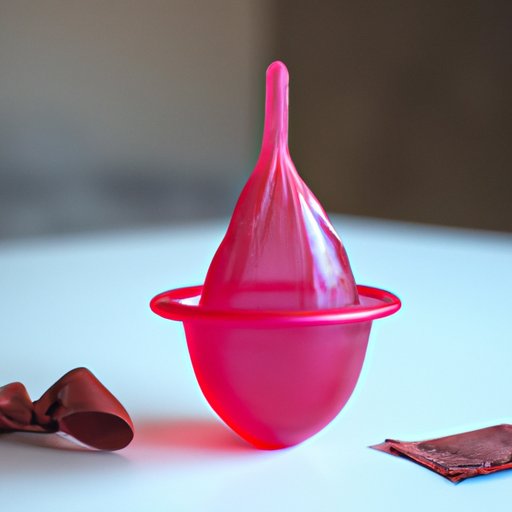Introduction
Periods are a natural part of life for many women, and it’s important to take care of yourself during this time of the month. One way to do this is by exercising while on your period. Although it can be challenging, there are many benefits to exercising during this time. In this article, we will explore the pros and cons of exercising on your period, as well as tips for making it easier. We will also look at what kinds of exercise can help reduce cramps.

Pros and Cons of Exercising on Your Period
Exercising on your period can be both beneficial and challenging. Let’s start by looking at the pros of exercising during this time.
Benefits of Exercising on Your Period
There are many benefits to exercising on your period, including improved physical health, increased mental clarity, and reduced cramps. Here’s a closer look at each benefit:
- Improved Physical Health: Exercise releases endorphins, which are hormones that make you feel good and help reduce stress. Regular exercise can also improve your overall physical health and help you stay in shape.
- Increased Mental Clarity: Exercise can also help improve your mental clarity. It can help you stay focused and more alert, which can be especially helpful during your period when you may be feeling tired and sluggish.
- Reduced Cramps: Exercise can also help reduce cramps. This is because exercise increases circulation, which helps reduce pain and inflammation.
Although there are many benefits to exercising on your period, there are also some challenges. Let’s take a look at these:
Challenges of Exercising on Your Period
The main challenges of exercising on your period include heavy bleeding, low energy levels, and difficulty concentrating. Here’s a closer look at each challenge:
- Heavy Bleeding: Heavy bleeding can make it difficult to exercise during your period. It can also be uncomfortable and embarrassing.
- Low Energy Levels: Low energy levels are common during your period, which can make it difficult to exercise. You may find that you need to take breaks or have shorter workouts than usual.
- Difficulty Concentrating: It can be difficult to concentrate when you are on your period, which can make it hard to focus on your workout. This can make it difficult to get through a full workout.
Tips for Exercising While on Your Period
If you want to exercise on your period, here are some tips to make it easier:
- Wear comfortable clothing: Wear clothes that are comfortable and breathable, such as leggings and a tank top. Avoid clothes that are too tight or restrictive.
- Drink plenty of fluids: Staying hydrated is important for any workout, but it’s especially important when you’re on your period. Drink plenty of water before, during, and after your workout to keep your body hydrated.
- Take breaks if needed: If you start to feel tired or overwhelmed, take a break. Listen to your body and give it the rest it needs.
- Listen to your body: Pay attention to how your body is feeling during your workout. If something doesn’t feel right, stop and take a break.

How to Make Exercising on Your Period Easier
Here are some tips for making exercising on your period easier:
- Start with low intensity exercises: Start with low-intensity exercises, such as walking or swimming. This will help you get used to exercising on your period without overdoing it.
- Choose activities that are enjoyable: Choose activities that you enjoy, such as cycling or yoga. This will make it easier to stick with your exercise routine.
- Use a menstrual cup: Using a menstrual cup can help reduce heavy bleeding, which can make exercising on your period easier.
- Use heating pads or other pain relief methods: Heating pads or other pain relief methods can help reduce cramps and make exercising on your period easier.
What Kinds of Exercise Can You Do on Your Period?
There are many different kinds of exercise that you can do on your period, including walking, swimming, cycling, and yoga. Here’s a closer look at each type of exercise:
- Walking: Walking is a great way to get some exercise while on your period. It’s low-impact and easy to do, so you won’t have to worry about overdoing it.
- Swimming: Swimming is another great option for exercising on your period. The water will help keep you cool while you exercise, and it’s low-impact so it won’t put too much strain on your body.
- Cycling: Cycling is a great way to get some cardio while on your period. It’s low-impact and can help you build up your endurance.
- Yoga: Yoga is a great way to stretch and relax your body while on your period. It’s low-impact and can help you stay in tune with your body.
Can Exercising on Your Period Help Reduce Cramps?
Yes, exercising on your period can help reduce cramps. Exercise releases endorphins, which are hormones that make you feel good and help reduce pain. Exercise can also increase circulation, which helps reduce cramps. So, if you’re dealing with cramps while on your period, try going for a walk or doing some light stretching to help relieve the pain.
Conclusion
Exercising on your period can be beneficial for both your physical and mental health. Although it can be challenging, there are many benefits to exercising during this time. There are also tips and tricks for making it easier, such as wearing comfortable clothing, drinking plenty of fluids, and taking breaks if needed. Plus, there are many types of exercise that can help reduce cramps. So, don’t be afraid to keep exercising on your period!
(Note: Is this article not meeting your expectations? Do you have knowledge or insights to share? Unlock new opportunities and expand your reach by joining our authors team. Click Registration to join us and share your expertise with our readers.)
